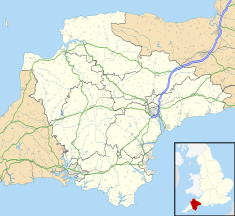Hillersdon House
| Hillersdon House | |
|---|---|
 Hillersdon House | |
| Location | Cullompton, Devon, England |
| Coordinates | 50°51′45″N 3°25′44″W / 50.86250°N 3.42889°W |
| Built | 1848 |
| Architect | Samuel Beazley |
Listed Building – Grade II* | |
| Official name | Hillersdon House |
| Designated | 5 April 1966[1] |
| Reference no. | 1326145 |
Listed Building – Grade II | |
| Official name | Stable block 50 metres north of Hillersdon House |
| Designated | 11 June 1986[2] |
| Reference no. | 1105931 |
Listed Building – Grade II | |
| Official name | Jane's Cottage 150 metres south-south-west of Hillersdon House |
| Designated | 11 June 1986[3] |
| Reference no. | 1168555 |
Hillersdon House in the parish of Cullompton in Devon, is a grade II* listed[1] late Georgian[4] style manor house overlooking that town. It was built in 1848 by William Charles Grant (1817-1877), to the design of Samuel Beazley, the notable theatre architect.[1][5]
Description
The house is a two-storey building arranged around a central hall,[1] built of red brick with Portland stone dressing and a hipped slate roof. The red brick stable block was built at about the same time as the main house along with "Jane's Cottage" within the grounds.[2][3] The main house is set out on an "H" plan around a central hall. The north-east front is the main entrance with a porte-cochère flanked by Tuscan columns, while the south-west side mirrors the north east but without the porte-cochère.[1] It is surrounded by landscaped gardens with ponds and a deer park.[6]
History

Hillersdon House was built in 1848 by William Charles Grant, a Lieutenant of the First (Kings) Dragoon Guards and a nephew of Sir William Grant (1752-1832), Member of Parliament, Solicitor General and Master of the Rolls.[7] Grant purchased the estate in about 1847.[7][8] In 1843 Grant had married Maria May (d.1891), a noted pteridologist.[9] and W.C. Grant built the surviving house to replace the earlier house which was in a dilapidated state,[10] and which had been offered for rent in the early 19th century.[11]
In 1877 W.C. Grant died and Hillersdon passed to his second and eldest surviving son William John Alexander Grant ("Johnny")[9][12][13][14] William John Alexander Grant (1851-1935),[7] a distinguished Arctic photographer who in 1895 married Enid Maud Forster, whom he divorced in 1901.[7][15] In the 1890s Hillersdon became known for its wild parties. One incident occurred after the Exeter Ball, when four young gentlemen plunged into one of the lakes, and were subsequently washed off in baths of champagne. Elinor Glyn, a noted society beauty was part of the house party on this occasion.[16]
After the death of William Grant in 1935 the house was inherited under his will by Sir Mark Beresford Russell Sturgis (1884–1949), KCB, Assistant Under-Secretary for Ireland, who took the additional surname of Grant, as a condition of the will. In the Second World War it housed US Officers and then became a bed and breakfast and later was divided into five flats.[17] It was purchased in 1982 by David and Gale Glynn, who having undertaken some refurbishment work sold it in 2010 for an asking price of £3-£4 million.[16]
In 2010, Hillersdon was purchased by Michael Lloyd and has since undergone a complete refurbishment and is now used as a wedding venue and hotel.[18]
References
- ^ a b c d e "Hillersdon House". National Heritage List for England. Historic England. Retrieved 13 August 2016.
- ^ a b "Stable block 50 metres north of Hillersdon House". National Heritage List for England. Historic England. Retrieved 13 August 2016.
- ^ a b "Jane's Cottage 150 metres south-south-west of Hillersdon House". National Heritage List for England. Historic England. Retrieved 13 August 2016.
- ^ Pevsner, Nikolaus & Cherry, Bridget, The Buildings of England: Devon, London, 2004, p.482
- ^ "Country houses for sale in Devon, Cornwall and Somerset". www.countrylife.co.uk. Retrieved 2 October 2009.
- ^ "Gardens". Hillersdon House. Retrieved 13 August 2016.
- ^ a b c d Burke's Genealogical and Heraldic History of the Landed Gentry, 15th Edition, ed. Pirie-Gordon, H., London, 1937, pp. 954–5, pedigree of "Grant of Hillersdon House"
- ^ Colvin and Moggridge, section 4.1
- ^ a b Colvin and Moggridge, section 4.2
- ^ Mitchell, J.C. (1851). Eight views of Cullompton and neighbourhood together with a concise compilation of explanatory particulars and description. Cullompton: I. Frost.
- ^ "Hillersdon House". Exeter Flying Post. 8 November 1821. Retrieved 13 August 2016 – via British Newspaper Archive.
- ^ "Leigh Smith Expeditions on board the Eira 1880, 1881-82". Freeze Frame. Retrieved 13 August 2016.
- ^ Wood, Janet. "Arctic Exploration: North West Pasage: The Pandora Voyage of 1876". World Through The Lens. Retrieved 13 August 2016.
- ^ "William Grant". The Library of Nineteenth-Century Photography. Retrieved 13 August 2016.
- ^ Colvin & Moggridge
- ^ a b Tyzack, Anna (5 June 2009). "Hillersdon House in Devon: a decadent affair". London: telegraph.co.uk. Retrieved 13 August 2016.
- ^ "History". Hillersdon House. Retrieved 13 August 2016.
- ^ "The House". Hillersdon House. Retrieved 13 August 2016.
Sources
- Colin and Moggridge (2011). Hillersdon House, Appendix 4, Archival Review of Landscape History. Retrieved 25 March 2017.
Further reading
- Hertford, Henry, A Cullompton Worthy, Devon and Cornwall Notes and Queries, Vol.19, 1936, pp. 132–6. (Re Robert Cockram, 1553-1632, Fellow of Oriel College, Oxford, and his ancestors)
- Hertford, Henry, Robert Cockram: a Cullompton Worthy, Devon and Cornwall Notes & Queries, Vol.170(?), 1936, pp. 401–2
- Gray, Todd, William Luccombe and the Iron Oaks of Hillersden in 1796, Devon Documents (ed. T. Gray). Tiverton: Devon & Cornwall Notes & Queries, Special Issue (1996) pp. 88–90.

